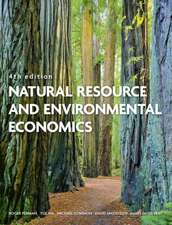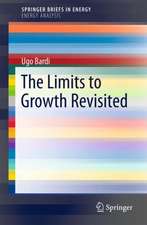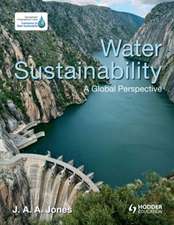Global to Local: Ecological Land Classification: Thunderbay, Ontario, Canada, August 14–17, 1994
Editat de Richard A. Sims, Ian G.W. Corns, Karel Klinkaen Limba Engleză Hardback – 29 feb 1996
This publication defines the current `state-of-the-art' of ELC. It provides particular insight into the role of ELC in current and future forest resource planning and management, and emphasizes its application and usefulness at various spatial scales, for a variety of geographic locations, and under a range of management scenarios/constraints. The book is an invaluable and substantial reference source about the current trends in ELC and will be of particular value to ecologists, foresters, geographers, resource managers, wildlife biologists, GIS and remote sensing specialists, educators and students.
| Toate formatele și edițiile | Preț | Express |
|---|---|---|
| Paperback (1) | 1232.41 lei 6-8 săpt. | |
| SPRINGER NETHERLANDS – 20 sep 2011 | 1232.41 lei 6-8 săpt. | |
| Hardback (1) | 1238.74 lei 6-8 săpt. | |
| SPRINGER NETHERLANDS – 29 feb 1996 | 1238.74 lei 6-8 săpt. |
Preț: 1238.74 lei
Preț vechi: 1510.66 lei
-18% Nou
Puncte Express: 1858
Preț estimativ în valută:
237.04€ • 248.11$ • 197.29£
237.04€ • 248.11$ • 197.29£
Carte tipărită la comandă
Livrare economică 31 martie-14 aprilie
Preluare comenzi: 021 569.72.76
Specificații
ISBN-13: 9780792339663
ISBN-10: 0792339665
Pagini: 610
Ilustrații: XIV, 610 p.
Dimensiuni: 156 x 234 x 33 mm
Greutate: 1.05 kg
Ediția:1996
Editura: SPRINGER NETHERLANDS
Colecția Springer
Locul publicării:Dordrecht, Netherlands
ISBN-10: 0792339665
Pagini: 610
Ilustrații: XIV, 610 p.
Dimensiuni: 156 x 234 x 33 mm
Greutate: 1.05 kg
Ediția:1996
Editura: SPRINGER NETHERLANDS
Colecția Springer
Locul publicării:Dordrecht, Netherlands
Public țintă
ResearchCuprins
1. Introduction.- — Global to Local: Ecological Land Classification.- Land Classification and Ecosystem Classification.- 2. Global Frameworks.- Multi-Scale Ecosystem Analysis.- A National Ecosystems Framework for Monitoring and Reporting on Environmental Sustainability in Canada.- The ITE Land Classification: Providing an Environmental Stratification of Great Britain.- Spatial Scale-Dependent Policy Planning for Land Management in Southern Europe.- 3. Regional Frameworks.- A Spatial Hierarchical Framework for the Co-Management of Ecosystems in Canada and the United States for the Upper Great Lakes Region.- Development of a Multilevel Ecological Classification System for the State of Minnesota.- A Strategic Framework to Eco-Regionalize Ontario.- Ecosystem Mapping Methods for British Columbia.- An Ecological Framework for Resource Management in British Columbia.- Land District, Ecophysiographic Units and Areas: The Landscape Mapping of the Ministère des Ressources Naturalles du Québec.- 4. Subregional Frameworks.- Developing an Ecological Land Classification for the Fundy Model Forest,Southeastern New Brunswick, Canada.- Ecological Mapping: A Framework for Delimiting Forest Management Units.- Application of the USDA Forest Service National Hierarchical Framework of Ecological Units at the Sub-Regional Level: The New England-New York Example.- Development of Ecological Land Classification and Mapping in Support of Forest Management in Northern Newfoundland, Canada.- Classification of Local- and Landscape-Scale Ecological Types in the Southern Appalachian Mountains.- 5. Local Frameworks.- Development of a Practical Forest Ecosystem Classification from Existing Biophysical Studies: An Approach Used in Northwestern Quebec.- A Forest Ecosystem Guide for the Amos LowlandsEcological Region, Northwestern Quebec: A Forest Management Approach.- Ecosystem Types of Boreal Forest in the North Klondike River Valley, Yukon Territory, and Their Productivity Potentials.- Impacts of Logging and Wildfire on an Upland Black Spruce Community in Northwestern Ontario.- A Community Classification System for Forest Evaluation: Development, Validation, and Extrapolation.- Landscape Ecosystem Classification in the Cherokee National Forest, East Tennessee, U.S.A..- Landtype-Forest Community Relationships: A Case Study on the Mid-Cumberland Plateau.- A Cooperative, Integrated Project to Classify Forest Sites in Newfoundland.- 6. Database Management.- The Development of an Ecological Classification Data Management and Analysis System for British Columbia.- The Countryside Information System: A Strategic-Level Decision Support System.- 7. Global to Local Modelling.- Linking Satellite and Field Survey Data, through the Use of Gis, as Implemented in Great Britain in the Countryside Survey 1990 Project.- Primary Databases for Forest Ecosystem Management — Examples from Ontario and Possibilities for Canada: Natgrid.- Forest Dynamics Modelling under Natural Fire Cycles: A Tool to Define Natural Mosaic Diversity for Forest Management.- Structural Characteristics of Post-Wildfire and Clearcut Landscapes.- 8. Soil Moisture Regime and Site Evaluation.- Classification of Moisture and Aeration Regimes in Sub-Boreal Forest Soils.- Tree Species in Relation to Soil Moisture Regime in Northwestern Ontario, Canada.- Effects of Decaying Wood on Eluviation, Podzolization, Acidification, and Nutrition in Soils with Different Moisture Regimes.- 9. Forest Site Quality and Productivity.- Forest Site-Quality Estimation Using Forest Ecosystem Classification in NorthwesternOntario.- Site Characteristics, Growth and Nutrition of Natural Red Pine Stands in Newfoundland.- A Soil-Site Evaluation Index of Productivity in Intensively Managed Pinus Radiata (D. Don) Plantations in South Australia.- 10. ELC-Based Management.- A Habitat-Based Microscale Forest Classification System for Zoning Wood Production Areas to Conserve a Rare Species Threatened by Logging Operations in South-Eastern Australia.- Use of Forest Ecosystem Classification Systems in Fire Management.- Forest Ecological Classification and Mapping: Their Application for Ecosystem Management in Newfoundland.- Ecological Land Classification as a Basic Theme for the Management of Wildlands in Tennessee: A Start.- 11. ELC-Based Research.- Genecological Variation Corresponding to Forest Ecosystem Classification Vegetation and Soil Types for Jack Pine and Black Spruce from Northwestern Ontario.- Diameter Distribution of Some Subalpine Fir Stands in Central British Columbia.











